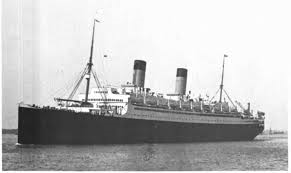
By 1922, the White Star Line had intended to operate a crack, three ship express service on the Atlantic with three almost identical, giant sister ships- the Olympic, Titanic, and Britannic.
Fate took out the second of these ships in the most resounding maritime tragedy in the years leading up to the Great War. The bullets that killed Archduke Franz Ferdinand and Empress Sophie in Sarajevo in June, 1914 found an echo in the mine explosion that sent the incomplete Britannic- serving as a makeshift hospital ship- to the bottom of the Aegean in 1916. By the time that peace returned to a shattered, exhausted Europe in 1918, only the Olympic remained of that once grand, unrealised dream.
Olympic at the time was described as ‘our one Ewe lamb’ by Harold Sanderson, managing director of White Star. But even as he spoke, Sanderson had already acquired a couple of surrendered German replacements for the two lost White Star juggernauts. The three ship service remained the ultimate dream for White Star and Cunard alike.
The reasons for a three ship service lay in simple scheduling and economics. White Star’s plans were for one ship to leave Southampton each Wednesday, bound for New York. A second ship would leave New York on Saturday, bound for Europe. The third ship would always be in mid Atlantic, heading in one direction or another.
In this way, the company could guarantee a weekly service, offering six day crossings on a year round basis. Cunard would also offer a similar service post war, but with different sailing dates.
The Olympic was soon joined on the service by the Majestic, the third of Albert Ballin’s intended trio of world beaters for the Hamburg America Line. She was the largest ship in the world and, crucially for White Star, her speed was roughly compatible to that of the Olympic. Her new owners called her ‘The Queen of the Western Ocean’ when she first set sail for them in May of 1922.
For their third vessel, White Star acquired a 35,000 ton liner, originally intended to be called Columbus. She remained incomplete in Germany during the war. Under White Star’s stewardship, the unfinished hulk was completed as Homeric She came round to Southampton in early 1922 to join the Olympic and Majestic on the platinum chip run to New York.
By far the smallest and slowest of the three, the Homeric would have seemed an odd choice at any normal time. But those post war years were not normal times. New tonnage was in pitifully short supply, and many shipyards needed to be reconfigured from war duties back to peacetime production. Like every other shipping line in those first, lean years, White Star had to make do with what it could get.
Her maiden voyage actually took place in February of 1922, from Southampton to New York. In terms of service, style and accommodation, the Homeric was every bit as plush, elegant and prestigious as her two larger siblings. Once settled down into regular passenger service, she proved popular enough for sure. With a passenger capacity of 2,145 across first (750), second (545) and third (850) plus a crew of 780, the Homeric provided twenties travellers with a safe, highly styled crossing of the Atlantic.
But she was a flawed, limping greyhound, capable of only an average speed of eighteen knots, against the routine twenty three knot crossings of her siblings. As a result of this imbalance, the White Star express schedule began slowly losing ground to Cunard. Fine ship that she was, the Homeric was simply not up to the rigours of the year round express service between Europe and New York. By 1927, she was already being sent on cheaper, off season cruises to the Mediterranean.
By 1929, the advent of the Great Depression had combined with the arrival of speedy, stylish new French and German liners to put the White Star Line on life support. By 1932, the ageing Homeric had been relegated to full time cruise duties, a role terminated by the shotgun wedding of Cunard and White Star in May of 1934.
With the Queen Mary already looming large in the rear view mirror, the new Cunard White Star Line began shedding surplus tonnage like some Stalinist purge. The end for the Homeric was officially announced in August of 1935. By 1938, she had been completely scrapped.
The Homeric never really had much of a chance. Slower than her fleet mates, she was soon outpaced in both the style and glamour stakes by newer, flashier foreign rivals. Even within the White Star ranks, she was something of a ‘poor sister’ when compared to the more prestigious Olympic and Majestic.
Still, there is something truly sad, almost indecent, about the way in which she seems to have almost vanished from the pages of history. Of itself, this small article is an attempt to redress part of that balance.